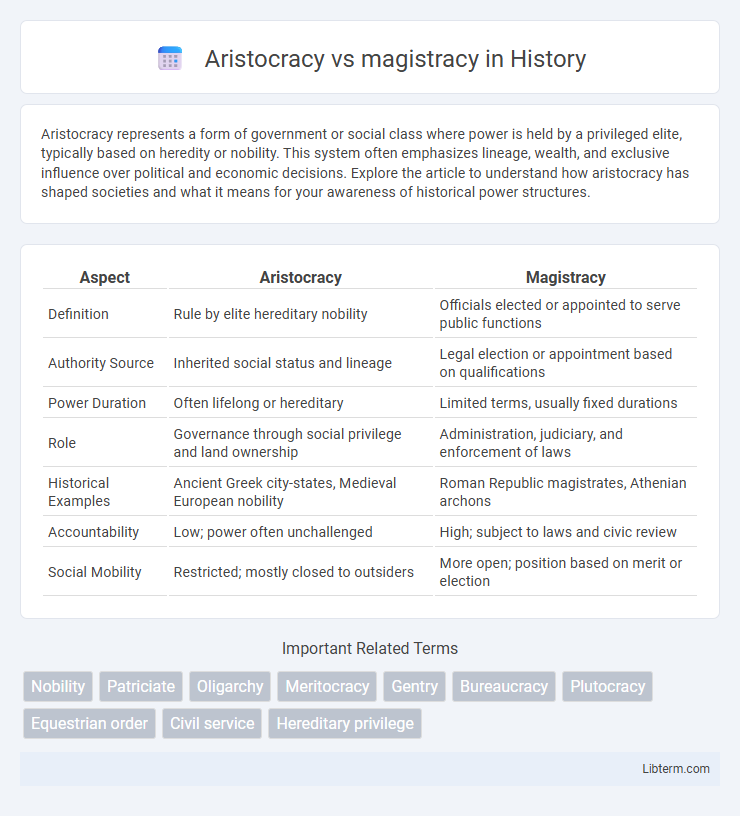Aristocracy represents a form of government or social class where power is held by a privileged elite, typically based on heredity or nobility. This system often emphasizes lineage, wealth, and exclusive influence over political and economic decisions. Explore the article to understand how aristocracy has shaped societies and what it means for your awareness of historical power structures.
Table of Comparison
| Aspect | Aristocracy | Magistracy |
|---|---|---|
| Definition | Rule by elite hereditary nobility | Officials elected or appointed to serve public functions |
| Authority Source | Inherited social status and lineage | Legal election or appointment based on qualifications |
| Power Duration | Often lifelong or hereditary | Limited terms, usually fixed durations |
| Role | Governance through social privilege and land ownership | Administration, judiciary, and enforcement of laws |
| Historical Examples | Ancient Greek city-states, Medieval European nobility | Roman Republic magistrates, Athenian archons |
| Accountability | Low; power often unchallenged | High; subject to laws and civic review |
| Social Mobility | Restricted; mostly closed to outsiders | More open; position based on merit or election |
Defining Aristocracy and Magistracy
Aristocracy refers to a form of government where power is concentrated in the hands of a privileged hereditary class, often characterized by noble lineage and wealth. Magistracy denotes a system of governance involving elected or appointed officials, magistrates, who hold judicial, administrative, or executive authority within a defined political structure. The aristocracy emphasizes birthright and social hierarchy, while magistracy underscores law enforcement and civic administration through designated officeholders.
Historical Origins of Aristocracy
Aristocracy originated in ancient Greek city-states as a form of government where power was held by a privileged class of landowning nobility, distinguished by hereditary titles and social status. This ruling elite maintained authority through control of wealth, military leadership, and religious influence, often justifying their dominance with notions of superior birth and virtue. In contrast, magistracy developed as a more administrative and judicial office within republican systems, where officials were typically appointed or elected to execute laws and manage civic affairs without inheriting their positions.
The Evolution of Magistracy Systems
The evolution of magistracy systems marks a significant shift from aristocratic rule, where power was concentrated in hereditary elites, to more structured and institutionalized governance roles defined by legal authority and administrative duties. Over time, magistracies developed formalized appointment processes, accountability mechanisms, and bureaucratic functions, distinguishing them from traditional aristocratic privileges rooted in lineage and social status. This transformation facilitated the emergence of more egalitarian political frameworks by emphasizing merit-based leadership and codified responsibilities.
Power Structures: Aristocrats vs Magistrates
Aristocracy represents a power structure where authority is concentrated in the hands of hereditary elites who inherit status and influence, often exercising control based on lineage and wealth. Magistracy, in contrast, consists of appointive or elective officials who hold administrative and judicial powers temporarily, emphasizing legal authority and meritocratic qualifications. This distinction outlines aristocrats as holders of enduring social dominance, while magistrates embody functional governance through institutional roles.
Social Impact: Class and Authority
Aristocracy historically concentrated power within hereditary elites, preserving social hierarchies and restricting upward mobility for lower classes. Magistracy, often based on merit or appointment, introduced a more structured legal authority that could moderate aristocratic dominance and influence social order. The tension between these systems shaped class dynamics by balancing inherited privilege against institutional governance and civic responsibility.
Political Influence and Governance
Aristocracy wields political influence through hereditary privileges and elite social status, often controlling governance by dominating key institutions and policymaking processes. Magistracy exercises authority via elected or appointed officials responsible for administration, law enforcement, and public order, emphasizing accountability and legal frameworks. The contrast lies in aristocracy's emphasis on lineage-based power, while magistracy depends on formal offices and institutional roles to govern.
Roles and Responsibilities Compared
Aristocracy typically involves hereditary elites who exercise power based on lineage, overseeing governance with a focus on maintaining social hierarchy and wealth control. Magistracy consists of appointed or elected officials responsible for administering laws, ensuring justice, and managing civic duties within a structured legal framework. The aristocratic role centers on broad, often privileged rule, whereas magistrates function through defined legal authority and accountability to the populace.
Aristocracy and Magistracy in Modern Times
Aristocracy in modern times typically refers to a privileged class holding inherited titles and social status, often exerting influence through wealth and historical heritage rather than formal political power. Magistracy remains an essential component of contemporary governance, involving appointed or elected officials responsible for judicial and administrative duties within the legal system. While aristocracy relies on lineage and tradition, magistracy functions through meritocratic principles and institutional frameworks to maintain law and order.
Criticisms and Controversies
Aristocracy faced criticism for concentrating power in the hands of a privileged elite, often leading to social inequality and exclusion of the broader population from political participation. Magistracy, while designed to distribute authority and prevent tyranny, sometimes encountered controversies due to susceptibility to corruption and manipulation by influential factions. Debates persist over whether aristocratic rule fosters stability or entrenches elitism, and if magistracies effectively balance power or merely replicate existing hierarchies under different titles.
Future of Aristocratic and Magisterial Systems
The future of aristocratic and magisterial systems hinges on their adaptability to modern governance demands, with aristocracy potentially evolving through meritocratic reforms and increased public accountability. Magisterial systems may expand their influence by integrating advanced technologies, such as blockchain for transparent judicial processes and AI-assisted decision-making to enhance efficiency. Both systems face challenges from democratization trends but can coexist by redefining roles that balance tradition with innovation in political and legal frameworks.
Aristocracy Infographic

 libterm.com
libterm.com